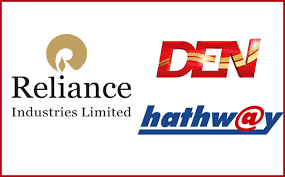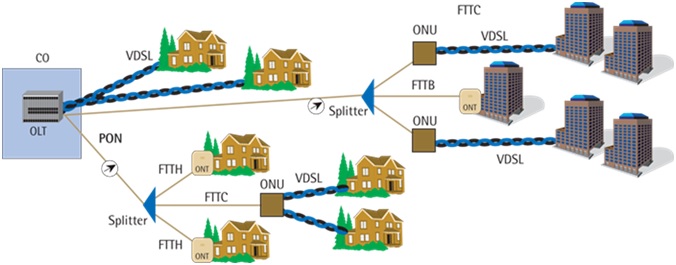
Current state of the Cable TV distribution business :
There are around 7 -8 national MSOs (Multi System Operators) that operate DAS (Digital Addressable System) Cable TV network through a complex web of JV partners, Distributors, Collection Agents and Business Managers operating multiple DVB-C (Digital Video Broadcasting – Cable) Network Operating Centre (NoC ) across the country. There are also about 1100 Independent MSOs (iMSOs) operating their self owned and controlled DVB-C NoCs State wide, City wide or in Towns. ( As per Ministry of Information & Broadcasting (MIB) last updated list as on 31.10.2017 of registered MSOs to operate anywhere in India the total registration counts to 1469 ( Around 200 DAS MSO registration applications are pending approval with MIB.)
Apart from these there are approximately 65,000 Last mile Cable TV service providers (LMOs) in the country, who; own , operate, upgrade and maintain their respective one-way (forward path) last mile Cable TV distribution plants that are only provisioned for (somehow connect & receive only) Cable TV services to approximately 100 Million households in the country, by re-distributing the digital cable TV signals being aggregated, processed and provided by these 1175 NoCs established by the DAS registered MSOs. (These figures do not include HITS (Headend in the Sky ) operator(s)) providing their signals to the last mile Cable TV operators for re-distribution to its managed and serviced households.
A Distribution Value Chain; Inherently Dishonest
The stake holders in this Cable TV Distribution Value Chain have no trust in-between themselves. The reasons for conflict and dissent, in brief are analyzed and enumerated as below:
- LMOs : Have had been the pampered lot & the weakest link in this Cable TV distribution chain, but post Digitalization (DAS implementation) they feel, they being exploited and are being forced to meet unreasonable payment demands of the MSOs to pay for all their connected households and pay TV channels been provided under forced bouquets. As of today they are paying an average Rs. 100 /- per STB (Set Top Box) deployed by their customers, after taking them from the respective MSO’s providing DAS DVB-C signals to them for re-distribution to the end-consumers. Whereas the end consumer of Cable TV services is paying an average Rs. 250/- per STB / month. Collected by the LMO. An average urban LMO is holding to about 750 households. (This Forward path only, hybrid last mile distribution plant laid to somehow connect is without ROW (Right of Way ) the manpower deployed, have remained unskilled with no proper training and are completely ignorant about standards and prescribed QoS regulations.
- Business Managers : ( Only in case of the National MSOs i.e. Hathway, DEN, Siti Cable, InCable etc. ) These were deputed to keep a check on the Distributor / JV partner activities and report pilferage of revenue collected and material issued. As of today they are taking the salary from their respective MSO company but are getting their daily allowance and perks from the Distributor / JV partner. Hence no pilferage of revenue or material is being reported. (Won’t be surprising if also holding to about 1000- 1500 Cable TV households of a LMO network made by a hostile takeover in connivance of the JV partner / Distributor.)
- Subscription Collection Agent : Is usually the local muscleman and also a conduit of arbitration between the Business Manager and the appointed Distributor or JV partner of the MSO company. ( Gets anywhere between Rs. 2 – Rs. 10 per STB / month as facilitation / collection fee. In addition he also manages to holds on to an average 3000 customer households) There is no data available on the actual number of these agents existence in the present system.
- Appointed Distributors : are usually the past iMSOs or the Collection agents or an Ex Business Manager of some MSO company. They are also the main PoP ( Point -of -Presence ) of the transported DVB-C signals over IP on a telecom operators network / or sometimes a full-fledged DVB-C NoC owned and operated by the MSO company. The signals are further provisioned for reaching the LMOs over a hybrid UG (underground ) or OH (Overhead) Optical fiber distribution plant, using Optical Tx (Transmitters ) and Optical Rx (Nodes ) pertinent to mention here that all the material used in deploying this Distributor to LMO, OFC (Optical Fiber Cable ) distribution plant is property of the MSO (Company) and the Distributor has to maintain it upon payment of a mutually negotiated fee ( Here itself there is pilferage of material and exorbitant maintenance charged) and partly shared with the company appointed BM (Business Manager) In addition to the above, he also holds about 35000 odd or more households directly with no declaration of the same made to the MSO Company.
- JV Partner: Are mostly the previous iMSOs who due to not having favorable interconnection regulations in place for pay TV content deals, lack of Digital Cable transmission technology know how at that time and not being inclined to put in own investments in this business due to mandatory digitalisation, had joined hands with the MSO company. Where they along with the BM and some distributors in place are maintaining and operating the NoC as a minority partner in this JV arrangement. But they are in complete control of the NoC to LMO hybrid distribution plant, These JV partners though in minority shareholding control and manage the business in their respective city of operations and around and interestingly is holding to about an average 60,000 households under a consortium of LMOs he himself got into a JV arrangement. Interestingly DEN Networks have about 116 JV partner entities as of now and a web of appointed distributors with no data available on these distributors.
Interestingly many of these JV Partners and appointed Distributors have also got their separate DAS MSO registrations done under a separate business entity. That have either been granted or been applied for. Moreover the basic technological knowhow of DVB-C has been understood in past 6 years of DAS implementation now and cost of setting up the required DVB-C infrastructure has been reduced by about 90%. The cost of the DVB-C receiving apparatus (STB) has been reduced to mere Rs. 500 per unit and that are being now also manufactured here.
Moreover Reliance JiO has announced its strategic investment in and partnership with Den Networks Limited and Hathway Cable and Datacom Limited. It aims to leverage on strengthening the 27,000 LCOs / LMOs that are aligned with DEN and Hathway to enable them to participate in the digital transformation of India. ( Wherein for doing so an additional investment of few thousand crores will be required to upgrade these existing last mile distribution plants for 2 way communication (bi-directional) to enable with return path data (RPD) )
This announcement comes only few days before the final verdict on the TRAI re-notified tariff and interconnection regulation which is expected from the Hon’ble Apex Court any day now. This will finally put an end to an year and half long speculations and delay in the implementation of TRAI re-notified; Tariff, QoS and Interconnection regulations.
That will to some large extent put an end to DPOs (Distribution Platform Operators ) that were directly or indirectly aligned to the pay TV broadcasters specially Star TV . Star TV was actually conducting this business in the background in the most unethical way. With the sole intention of Cartelization, Monopolization and thereafter its Monetization in most bizarre ways, as the parent company has now sold off its business to Disney. What we all will witness is that they won’t be inclined to carry along any previous baggage’s with them from Star TV. Whereas their remaining interests held in Sports broadcasting will soon be limited to only providing a clean feed to the public broadcaster (DD) on an advertisement revenue share basis and some subscription and advertisement collection from Sports channel(s) broadcast in HD and UHD format from its very limited takers.
Shri. Mukesh D Ambani ji comes from an engineering background and completely understands this business as well. He had once hired industry veterans like Lt. Col. V.C Khare to understand this content distribution business to its core. He was joined in by Mr. K. Jayaraman, another industry veteran who has actually built Hathway Cable and Datacom Limited starting from scratch himself. At Star TV investments made in this ground distribution cable MSO company, after its fall out with the Zee Group. The sole idea was to also have substantial presence on ground distribution to ensure its channel(s) viewership and TRPs by their compulsory carriage on prime band and to avoid any blacking out of channels when converting them to pay TV.
As per my understanding (perhaps can be wrong) Reliance Jio has made an announcement to put an investment of about Rs. 5000 Cr and more and to take complete control of DEN Networks Ltd and an management control of Hathway Cable and Datacom Ltd and that it will continue to do this for Rs.130 for BST (Basic Service Tier ) and plus 35% maximum incentive on the pay TV declared MRP. In addition to this they agreed that this revenue would be further shared with the LMOs on 55:45 or as prescribed in the regulations. Reliance Jio would do IPTV and VAS whereas this linear content distribution business is to be considered a mere 10-15 % of its much larger game plan.
Hathway Cable and Datacom Limited has got a much better deal as it has a good base of direct subscribers and Internet users and they have continued to religiously follow the systems put in place by Mr. Jayaraman during his long tenure as the CEO / M.D 1997 – 2014. At present there are only 2 JV partner entities, that have progressively grown and there seems no dissent as they have also been openly invited to make an offer to Reliance Jio and get their respective deals negotiated.
DEN Networks Limited ; A byproduct of Star DEN and churning out to peon level at Hathway Cable in 2007. A MSO company that was purely established to connect, get valuations and immediately sell and exit this business, it went even to the extent of swindling its investors i.e Goldman Sachs and its preferred vendor CISCO.
Whereas even Comcast and Goldman Sachs came to easily know upon conducting its due diligence on DEN Networks Limited that its books are cooked. Reliance Jio will be putting them to a much finer scrutiny and as been aforesaid I repeat here (They have been inherently dishonest to each other in this distribution value chain ) The Promoters, The Management, The Employees, The JV Partners, Distributors, Vendors, Investors and the Last Mile Operators share an eminent discord, the foundation of its business was built upon deceit and short term gains.
This DEN Networks deal with Reliance Jio, throwing in a bait of about Rs. 2000 Crores upon it for a complete takeover which will be the bone of contention, as the Promoters would not like to pass this down to the requisite levels of its well deserving 116 JV partners and more complex web of distributors and connected LMOs thus, will lead to confrontations, legal procedures and will see litigation as an only remedy to solve differences and get the piece of the cake. where DEN claims as per its 2017 – 2018 Annual Report – 11.3 million digital subscribers it has.
Respected Shri. Mukesh D Ambani ji is no novice to need an advice on this, but he is very short of time so as to spend on deliberations, Therefore in all fairness and avoiding unnecessary conflicts that are yet to begin, its advised that Reliance Jio fully concentrates fulfilling its envisaged business endeavors with Hathway Cable and Datacom Limited and its JV partners. While keeping the DEN Networks deal on the side in absolute silence for at least a year – till Q1 – 2020.
As there is all likelihood of situation(s) changing on the ground, post implementation of TRAI Tariff and Interconnection Regulations 2017. Therefore it wont be incorrect to say, that taking the right decision now can save Reliance Jio and its shareholders at large, from accruing unnecessary and avoidable losses. While it can continue to consolidate and upgrade its large directly owned and indirectly controlled last mile access to consumer households for its targeted all IP play services.
Even though we do understand and have seen the fate of the previous TV-18 Promoters and management but if some right decisions made at the right hour can easily avoid foreseen loss, unnecessary confrontation and unjust enrichments for few, it is worth the effort. It has been rightly said that ;
“Nine-tenths of wisdom is being wise in time.”
Email Communication addressed to RIL top Management including investor relations : VC Email Communication to RIL 24.10.2018 and 31.10.2018
Vikki Choudhry:
An Indian, Activist, Strategist, Visionary Investor & Entrepreneur in Entertainment, Broadcast, Next Generation Telecommunication, Analytics, Technology and Make in India.
He is a life member of the prestigious BES “Broadcast Engineering Society” and SCTE India “Society of Cable Telecommunications Engineers” India, and an industry observer.
A hands on promoter and has been amongst the leading entrepreneurs in the Digital Cable and Broadband Fraternity with over 25 years of experience in the cable TV and broadband service delivery industry.
He has represented the difficulties and woes of the Broadcasting industry before the regulatory departments and ministries in the Government of India. Above all, his readiness to help and advice and agitate issues for the betterment of broadcasting and telecommunication industry in India has always been appreciated by all associated with it.


